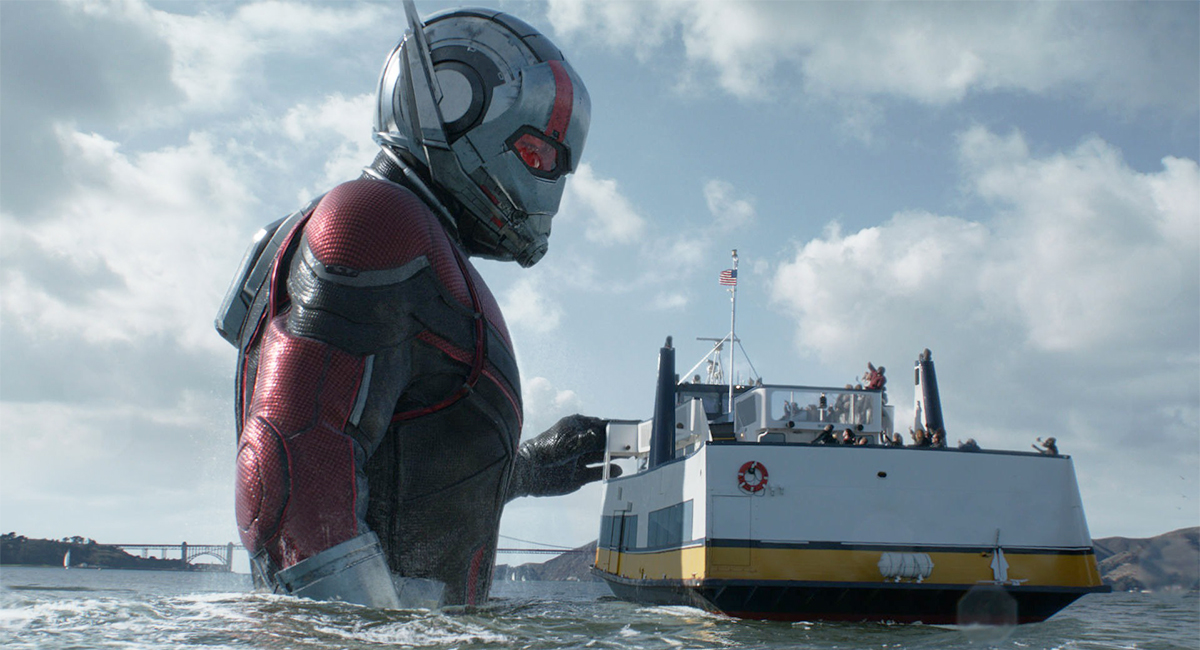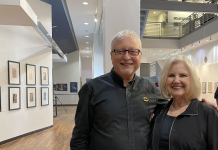By Daniel W. Rasmus
With Hollywood on mute at this year’s Comic-Con, programming shifted. No one slept overnight for a panel. The once-hallowed Hall H panels were smaller, sometimes much smaller, as trailers, preview episodes, and teasers substituted for insights and conversation.
But insights and conversation took place throughout the Con, much of it about science. Attendees packed into rooms uphill and over at the Marriott Marquis San Diego Marina, and across the street at the Omni, and off the winding hallways of the San Diego Convention Center.
I counted 20 panels that focused on science, and there were more that referenced it. I made it my mission to attend as many as possible, but alas, the tasks proved daunting, as organizers often overlapped science panels, forcing me and other attendees to make choices we didn’t want to take.
One of those scheduling issues involved a panel I organized, titled Exploring the Science in Science Fiction, now in its second year. It was pitted against the Scientific Problems of Dating a Vampire, a Werewolf, or Other Monsters. Those dating spacefaring vampires were screwed.
Other panels ranged from Neurological/Neurosurgical Controversies of the Comic Book Universe and The MacGyvers of Medicine to property-specific offerings on the Science of Avatar: The Way or Water and The Science of Spider-man. The Arrowverse recognized its narrative license with The Science (and Schimience) of the Arrowverse.
Some panels, like Improving Sci-Fi Storytelling Through Science Accuracy, focused on the role of science in fiction, while others, like Fear and Fungi: Science of The Last of Us and It’s Alive, Jim! Evolutionary Biology in Star Trek took on the role of education and myth-busting.
I made it to five panels. I think they provided ample insight into the role science can and should play at Comic-Con. Here are my 10 takeaways.
- Comic-Con Attendees Love Science. From late-night panels on Thursday night to those held at the Marriott late on Sunday, Comic-Con’s volunteer scouts had their work cut out for them as they tried to find seats for people in rooms clearly scheduled in anticipation of smaller crowds.
- Follow your own rules. Several scientists took issue with properties that don’t follow their own rules. The Flash, for instance, is notorious for Barry Allen’s power being explained in different ways or given certain constraints that later don’t fit into the plot, so they change. Joy Lin, nerdy comic and math teacher, points out that Wolverine’s hair grows out to the exact same length and shape after a battle, but then later in Wolverine, he is shown getting a haircut. There is a way to get around some inconsistencies. “Don’t explain things,” Lin admonishes Hollywood, “like shrinking the space between atoms.” If that is how Pym Particles work, then tiny Ant-Man would have a tiny punch, and a giant Ant-Man would exist “like a cotton candy.” Perhaps, the best way to avoid breaking rules is not to establish them at all.
- The universe is an endless and amazing place full of inspiring ideas. JPL’s Tiffany Kataria clearly loves the universe. But she really loves HD189733b and its hostile, supersonic wind and silicate-dissolving atmosphere. But a choice like this derives from studying what are now dozens of exoplanets, from hot Jupiters to Super-Earths revolving around myriad stars hundreds or thousands of light-years away. Tools like the Webb Space Telescope serve up new wonders almost daily. Blue Origin’s Max Fagin describes humans being able to fly on Titan with cardboard wings. He wants to see more science fiction set on this most earthlike of the solar system’s moons.
- There is no universal working relationship with science consultants. Some films and television shows just want people to check their work, and they may not incorporate their notes. Others want scientists to be part of the creative process (see the next bullet). According to Clifford Johnson, “Marvel is great, as they talk to a lot of different scientists, and that’s great. They get lots of different views on the same science, or they bring someone in to talk about the physics of time, or astrophysics…that’s been really healthy.”
- Science can inspire stories as much as ground them. Improving Sci-Fi Storytelling Through Science Accuracy moderator Jose Gonzalez Jr. observed, “You want someone who won’t just tell you yes or no… you want someone who will help you with your creative process instead of just putting up walls.” Avenger’s science advisor, Clifford Johnson, followed that with, “I want to change the model. I want to help creators tell their stories. I let them know that’s why I’m there…Tell me about the story, perhaps there is a bit of science…the more they tell me, the more I can help. Sometimes I may say no, that isn’t how it works, but here’s this other bit of science that may help. Some of the greatest collaborations start off with buzzwords, but some conversations lead to entire plotlines or episodes. People are really excited about science, not just the audience and the creators as well. Most of the view of not putting in science come from gatekeepers at the top saying, ‘I don’t understand this, so the audience won’t.’”
- Scientists are inspired by science fiction. Many of the scientists who discussed their backgrounds shared that it was science fiction that inspired them to become scientists. That we could not yet actually do some of the wonders presented in comic books, films, and television drove them to figure out why or how. Paleontologist Trevor Valle shared that two of his friends, inspired by Jurassic Park to become paleontologists, reenacted the “velociraptor” claw scene at the spot where the scene was shot in the first Jurassic Park movie, revealing an engagement ring along with the claw.
- Superhero science is very different from hard science fiction. Superhero science often conflates and inflates the possibilities of science. Rewriting DNA, while it may prove effective in treating some diseases, is not going to transform an existing organism during its lifetime. Emulating Sue Storm-like invisibility may someday prove possible through adaptive camouflage, but it is unlikely anyone will gain X-Men’s Storm weather manipulation powers. Unlike space flight, paleontology, and infectious diseases, some superhero “science” has little foundation in actual science, regardless of how severe the solar storm or gamma radiation exposure may be. In shows like The Expanse, however, spaceflight, which requires acceleration and deceleration, and station-keeping thrusters demonstrate how hard spaceflight is, which is one of the reasons writers create shortcuts—to move the plot along. As for superheroes, if creators were limited to just what was possible in science, most of our heroes would end up being pretty much the same—the universe of superheroes wouldn’t exist. Good thing creativity is a superpower that knows no bounds.
- Even the seemingly accurate science fiction lets story win over science. DNA from amber-preserved mosquitos seems reasonable. Well… The red blood cells shown in Jurassic Park contain no DNA. Mosquitos drink blood for iron and proteins to drive egg development. Male mosquitos do not bite. When female mosquitoes tap in, they also pick up leukocytes, which do contain DNA. And then there is the dearth of mosquitos in amber from the age of the dinosaurs, and the degradation of DNA. Those facts overcomplicate the red-blood-cell-sucking mosquito in amber story touted in the book and movie (and shown in the film’s introductory cartoony exposition). As much as Jurassic Park professed science, much of it was implausible, impossible, or just wrong—in service to the story. In another example, JPL’s Dr. Morgan Cable explained that the black hole in Interstellar should have been asymmetrical due to its enormous mass, but it didn’t look good on film, so Nolan and his team opted for a symmetric black hole.
- Real science (and nature) is pretty bizarre. There was universal acknowledgment among biologists that life on Earth can be pretty alien and is not all that well understood. Case in point, the lowly flatworm, that when cut in half, regenerates an entire body from the tail portion and somehow retains memories (see Clark, Liat, Study: decapitated flatworms retain memories, transfer to new brains, Wired UK) without the severed part receiving any brain tissue. Sometimes, Clifford Johnson stated, “many times some of the most bizarre things…are science fact, not science fiction.” Professor of Epidemiology, Tara Smith added, “There is a lot of craziness in nature; we don’t have to use these tropes [like viruses escaping from a lab] because mother nature does a really good job of creating things that can spread [like fungi, viruses, and bacteria].”
- SDCC needs to organize its science panels better. Although a Science-STEM track was available through the scheduling app, the coding was inconsistent, with some panels missing and others misclassified as science but clearly not science (such as the Afghan Youth Art and Poetry Exchange and Comic Book Law School®). Comic-Con would benefit from a science programming curator, but even more importantly, from a track that ensures science panels don’t compete for time (and have time between them for travel) regardless of an official science curator.
There were several suspension-of-belief breaker takeaways from the panels, some of them offered multiple times, such as the impossibility of molecular beings existing at subatomic levels (as in the Quantum Realm), that Ant-Man’s Giant-Man incarnation would behave more like a balloon (or cotton candy) than a heavy giant (because he has the same mass as his smaller form), and that dog fighting in space is never going to be a thing.
On the flip side, many scientists acknowledge that some form of the multiverse probably exists—though we may never interact with it—we’ll probably create materials that borrow from cuttlefish and master fast environmental mimicry, that someday we will likely reach very fast speeds in space, and that life probably exists elsewhere in the cosmos, even if we haven’t found it yet.
What we learned for certain over the span of San Diego Comic-Con 2023 was that for many of the attendees, their goal was not just to hang out with those who love comics, science fiction, and fantasy and to gain the inside scoop on their favorite franchise or pick up a precious, exclusive collectible—many of those attendees also arrived with their thinking caps primed, their curiosity heightened and their minds open to new possibilities that only science can deliver.
For those who want to continue exploring the science of science fiction, Roddenberry Entertainment & Den of Geek announced a new podcast titled Does It Fly? featuring scientist and self-professed nerd Dr. Hakeem Oluseyi and pop-culture enthusiast Tamara Krinsky. The podcast draws inspiration from Gene Roddenberry’s command to production designer Matt Jefferies during the design of the original Starship Enterprise: “I want it to fly.” The podcast will explore a wide range of science fiction ideas to see what is real, what is possible, and what is pure fiction.
The first episode of Does It Fly? arrives this Fall, with episodes posted weekly. Does It Fly? will be distributed through Den of Geek (denofgeek.com) as well as Apple Podcasts and other podcast platforms.










